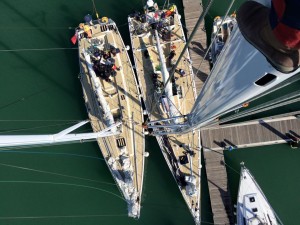As I write ( on Wednesday 9th December ) the Garmin boat, upon which The Story Bazaar’s correspondent sails, is fighting it out with two other boats, Great Britain and Mission Performance, for second position in Leg 4 of the Clipper Round the World yacht race to Sydney.  They are about to round Port Arthur, just south of Hobart in Tasmania, before heading north again. The fleet set out from Albany at the start of December with Garmin at fifth in the overall standings after the first three legs. They are now 866 nautical miles from landfall at Sydney having been sailing for 7 days. The estimated arrival window is between 12th and 14th December. Read Sue’s contribution – dated Sunday – to the official crew diary here.
They are about to round Port Arthur, just south of Hobart in Tasmania, before heading north again. The fleet set out from Albany at the start of December with Garmin at fifth in the overall standings after the first three legs. They are now 866 nautical miles from landfall at Sydney having been sailing for 7 days. The estimated arrival window is between 12th and 14th December. Read Sue’s contribution – dated Sunday – to the official crew diary here.
This leg takes the fleet further south than any other, into the ‘sleigh ride’ of the Roaring Forties, the winds which never stop blowing and the current that circles the world, without the obstacle of any land in its way. At latitude -43 degrees, Garmin’s present position, there have been strong headwinds and the boat has been forced to tack into the wind, while going ever further south. This is when all the training and preparation, shared with readers of The Story Bazaar, comes into its own. Rather Sue than me. Read today’s skipper’s report here.
Any circumnavigation of the globe includes the traditional ‘three great capes’, Cape Horn in Chile, the Cape of Good Hope in South Arica ( although  sometimes Cape Alguhas is cited as the tip of the African continent ) and Cape Leeuwin, Australia. Today the South East Cape of Tasmania and the South West cape of New Zealand are also often included. This is the traditional sea clipper route and Cape Leeuwin and Cape South East are included in this leg of the modern Clipper Race.
sometimes Cape Alguhas is cited as the tip of the African continent ) and Cape Leeuwin, Australia. Today the South East Cape of Tasmania and the South West cape of New Zealand are also often included. This is the traditional sea clipper route and Cape Leeuwin and Cape South East are included in this leg of the modern Clipper Race.
Clippers were 19th century trading vessels, carrying tea from India, opium from China and other exotic goods back to Europe. Usually three-masted, their design was based upon the original ‘Baltimore clippers’ which plied their trade on the north American sea-board, swift, narrow and cutting through the waves at a high rate of knots. ‘The Cutty Sark’, perhaps the most famous surviving clipper, is now restored and available to visit, in Greenwich, London, she was one of the last ‘tea clippers’ to be built at the apogee of clipper design. She was therefore one of the swiftest and she made the fastest passage from Plymouth to Sydney, via the traditional route, in 72 days. The Clipper Race boats won’t do it so quickly, they are expected to take approximately 102 days, but with a number of rest days included. I can’t say exactly how many, because different boats arrive and, sometimes, leave, at different times on different days.
Sue will be sending back a report on her time amidst the thirty foot waves when she reaches Sydney, where she and the rest of the Clipper fleet will spend Christmas, before preparing for the Sydney to Hobart Race, which begins on Boxing Day. This is the iconic equivalent of the northern hemisphere’s Fastnet Race and it was one of the reasons why Sue decided to do the Southern hemisphere leg of the circumnavigation. Estimated arrival window in Hobart 30/31st December. Just time for a New Year’s celebration before it’s off, on 2nd January, to Airlie Beach, Western Australia.
The Clipper web-site has a constantly up-dated race tracker if you want to follow the race. Though be warned. boats can go into ‘stealth mode’ as Garmin has done, a tactical ploy to hide their position from their competitors. When in ‘stealth’ a boat cannot be tracked by either the opposition or those following on the race tracker.
If you enjoyed reading this piece you might also enjoy Ready?! Sadness and Determination Trust A Nautical Adventure Naming Day


 RSS – Posts
RSS – Posts
One response to “Clipper News”